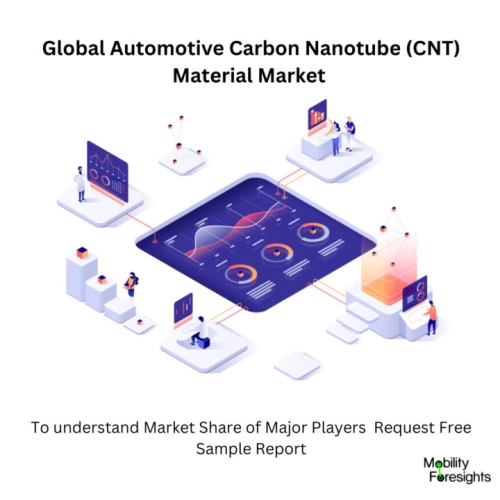
- Get in Touch with Us

Last Updated: Apr 25, 2025 | Study Period: 2023-2030
Carbon allotropes include carbon nanotubes (CNTs). A carbon nanotube is a seamless cylinder made of a sheet of graphite (also known as graphene) that is one atom thick and has a diameter of the order of a nanometer.
The sp2 nanocarbon substance known as carbon nanotubes (CNTs) has tubular shapes made of rolled-up graphene sheets. They also have amazing features, some of which are derived from comparable graphite qualities and others from their one-dimensional aspects, in addition to their distinctive nanostructures.

The Global automotive carbon nanotube (CNT) material market accounted for $XX Billion in 2022 and is anticipated to reach $XX Billion by 2030, registering a CAGR of XX% from 2023 to 2030.
LG Chem to Build Fourth Carbon Nanotube Plant.With the development of the largest single-line CNT production facility in the world, LG Chem is increasing its investment in carbon nanotubes (CNT).
The new facility is a component of LG Chem's strategy to strengthen its position as a leader in the electric vehicle (EV) battery-focused, rapidly expanding worldwide CNT industry.
A material of the future, CNT is 100 times stronger than steel and has the same electrical and thermal conductivity as copper and diamond. CNT has a number of uses in batteries, semiconductor wafer trays, automotive components, and surface heating elements because of its superior qualities to those of current materials.
The CNT produced by LG Chem is created utilising in-house cobalt-based catalysts that help reduce magnetic impurities, which might have a detrimental impact on battery performance.
Furthermore, due to advantages associated with enhanced reactor stability and process automation, LG Chem's Plant 4 is anticipated to have a production capacity per line that is 20% greater than that of its other facilities.
With intentions to spread utilisation to a wider variety of sectors, LG Chem's CNTs will be provided to battery manufacturers like LG Energy Solution, the current market leader in the world for EV batteries, as conductive additives.
| Sl no | Topic |
| 1 | Market Segmentation |
| 2 | Scope of the report |
| 3 | Abbreviations |
| 4 | Research Methodology |
| 5 | Executive Summary |
| 6 | Introduction |
| 7 | Insights from Industry stakeholders |
| 8 | Cost breakdown of Product by sub-components and average profit margin |
| 9 | Disruptive innovation in the Industry |
| 10 | Technology trends in the Industry |
| 11 | Consumer trends in the industry |
| 12 | Recent Production Milestones |
| 13 | Component Manufacturing in US, EU and China |
| 14 | COVID-19 impact on overall market |
| 15 | COVID-19 impact on Production of components |
| 16 | COVID-19 impact on Point of sale |
| 17 | Market Segmentation, Dynamics and Forecast by Geography, 2023-2030 |
| 18 | Market Segmentation, Dynamics and Forecast by Product Type, 2023-2030 |
| 19 | Market Segmentation, Dynamics and Forecast by Application, 2023-2030 |
| 20 | Market Segmentation, Dynamics and Forecast by End use, 2023-2030 |
| 21 | Product installation rate by OEM, 2023 |
| 22 | Incline/Decline in Average B-2-B selling price in past 5 years |
| 23 | Competition from substitute products |
| 24 | Gross margin and average profitability of suppliers |
| 25 | New product development in past 12 months |
| 26 | M&A in past 12 months |
| 27 | Growth strategy of leading players |
| 28 | Market share of vendors, 2023 |
| 29 | Company Profiles |
| 30 | Unmet needs and opportunity for new suppliers |
| 31 | Conclusion |
| 32 | Appendix |